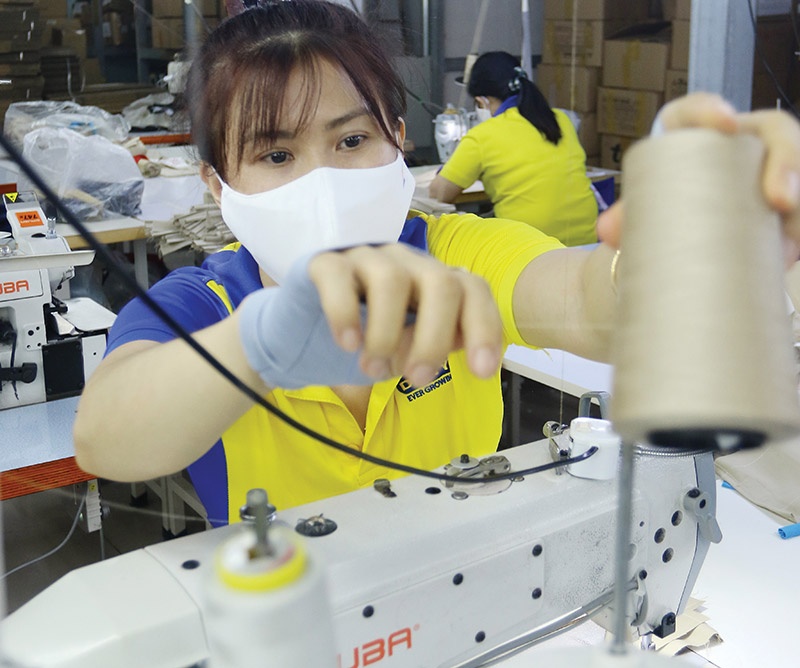Textile groups in demand slump
 |
| Textile groups in demand slump |
Garment maker Hugaco JSC is striving for revenue targets of about $32.6 million and a pretax profit of around $3.5 million in 2022. Pham Thi Phuong Hoa, general director of Hugoco worries, “The sourcing of materials will not be as abundant as in previous years as the market is expected to remain challenged by logistical congestion, production disruptions, and high transport costs.”
The decline in shopping demand is also dragging the market down, affecting all textile segments in Vietnam. Garment 10 Corporation has orders until the end of Q3, with its main products – shirts and suits – also in demand moving towards the end of this year.
Than Duc Viet, general director of the company, said, “I’m concerned about the slow consumption of the market, the increase in inventory, and that buyers could reduce or even cancel orders.”
Demand for children’s clothing, which is usually less affected by economic crises, is also slowing down.
Khuong Van Tai, director of Factory 8 Cam Thuy Branch of Ho Guom Group, confirmed, “Buyers have adjusted the number of products in their orders. We remain in a strong position, but from the second quarter, the number of orders was fewer than 200,000 units, accounting for only 20 per cent of the total export volume. Previously, the average contract between Cam Thuy and US buyers usually amounted to up to 400,000 products of children’s clothing.”
The last months of the year are often the time for textile makers to boost production to complete the signed textile export orders, which coincides with an increase in the price of raw materials around the world.
Cao Huu Hieu, general director of the Vietnam National Textile and Garment Group, said that the business is under great pressure from skyrocketing prices of input material prices.
“Imported goods arrive very slowly. Currently, the price of cotton has increased by about 19 per cent compared to the beginning of the year, and the prices of other man-made fibres also climbed significantly due to the high price of petrochemicals,” Hieu said.
According to the Vietnam Textile and Apparel Association, garment and textile exports in the first six months of the year were estimated at about $22.3 billion, showing a strong recovery with growth of 17.7 per cent over the same period last year.
However, from the middle of the second quarter of 2022, fluctuations in the market and global inflation may cause this growth to slow down in the third and fourth quarters.
As some buyers overbought towards the end of 2021 and into this year, excess pressure on export companies have led to a reduction in orders for the third and fourth quarters of 2022.
Last year marked a rebound in the import value of textiles and garments. In 2021, textiles and garments entering the US market reached $114 billion, up 27.2 per cent compared to 2020 and 2.7 per cent compared to 2019, of which imports from Vietnam increased by 15.2 per cent compared to 2020 and 7.2 per cent on-year, according to data from the Office of Textiles and Apparel under the US Department of Commerce.
Vietnam’s many free trade agreements are actively supporting textile and garment exports. However, the lack of autonomy in the sourcing of raw materials, as well as the focus on processing, renders the profit margins of the second-largest garment-exporting country in the world narrow at only about 5-6 per cent, as calculated by domestic analysts.
The export value to the EU, the world’s largest garment import market, only accounts for about 6 per cent of Vietnam’s total textile and garment export turnover. Strict standards of origin and fragmented supply chains currently prevent Vietnamese businesses from taking full advantage of the benefits of its trade deals.
In the EU, Vietnam’s textiles and garments are having to compete with Bangladeshi and Turkish equivalents, both of which are closer to the bloc and can export for cheaper.
Garment 10’s plan to increase exports to the EU market by 15 per cent next year also faces challenges.
Viet from Garment 10 said, “Exports to the EU account for 32 per cent of our export volume. The pressure is huge as more shoppers are asking to use recycled materials, which decompose after 5-10 years.”
The European Commission is implementing measures to address the challenges of the textile industry within the Green Deal framework, which aims to create efficient and competitive resource extraction and usage.
What the stars mean:
★ Poor ★ ★ Promising ★★★ Good ★★★★ Very good ★★★★★ Exceptional
 Tag:
Tag:
Related Contents
Latest News
More News
- Nghi Son refinery processes first non-Kuwaiti crude cargo (January 16, 2026 | 16:06)
- Siemens and VSIP announce landmark strategic partnership (January 15, 2026 | 14:48)
- VinFast sets record with 175,099 electric vehicles delivered in Vietnam in 2025 (January 15, 2026 | 14:24)
- Year-end shopping season faces rising uncertainty (January 14, 2026 | 18:11)
- State sector sees broad-based profit surge as major groups deliver strong results (January 13, 2026 | 17:34)
- HSBC forecasts Vietnam's GDP growth to hit 6.7 per cent in 2026 (January 13, 2026 | 17:33)
- Japfa maintains position in top 10 animal feed firms (January 13, 2026 | 10:18)
- Roadmap shaping up to phase out gas bikes (January 13, 2026 | 10:07)
- FDI momentum accelerates transformation of Vietnam’s plastics sector (January 11, 2026 | 07:00)
- UOB lifts Vietnam growth outlook to 7.5 per cent for 2026 (January 10, 2026 | 09:00)





















 Mobile Version
Mobile Version